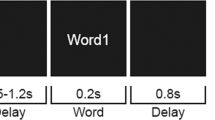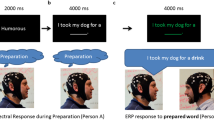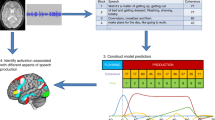Abstract
To investigate the influence of proficiency level on the cortical organization of foreign language processing, two groups of German speaking students, differing only in their proficiency in English as a second language, were subjected to EEG coherence analysis during foreign and native language processing (news reports, alpha1 frequency band). In the group with minor experience with English, coherence increase was observed with all electrode combinations, with left hemisphere (LH) predominance. In the high proficiency group, coherence increase was limited to temporal electrodes over LH. In the latter group only, coherence between prefrontal electrodes was significantly lower during the language tasks than during the baseline task (silence, noisy screen). Both results were obtained with foreign as well as native language processing. We suggest that reduced EEG coherence in highly proficient foreign language speakers reflects a more efficient operating strategy not only for their second, but also for their native language.


Similar content being viewed by others
References
Aglioti S, Fabbro F (1993) Paradoxical selective recovery in a bilingual aphasic following subcortical lesions. Neuroreport 4:1359–1362
Blair RC, Higgins JJ, Karniski W, Kromrey JD (1994) A study of multivariate permutation tests which may replace Hotelling’s T2 test in Prescribed Circumstances. Multivariate Behav Res 29:141–163
Chee MW, Caplan D, Soon CS, Sriram N, Tan EW, Thiel T, Weekes B (1999) Processing of visually presented sentences in Mandarin and English studied with fMRI. Neuron 23:127–137
Chee MW, Hon N, Lee HL, Soon CS (2001) Relative language proficiency modulates BOLD signal change when bilinguals perform semantic judgments. Blood oxygen level dependent. Neuroimage 13:1155–1163
Dehaene S, Dupoux E, Mehler J, Cohen L, Paulesu E, Perani D, van de Moortele PF, Lehericy S, Le Bihan D (1997) Anatomical variability in the cortical representation of first and second language. Neuroreport 8:3809–3815
Duncan J, Owen AM (2000) Common regions of the human frontal lobe recruited by diverse cognitive demands. Trends Neurosci 23:475–483
Essl M, Rappelsberger P (1998) EEG coherence and reference signals: experimental results and mathematical explanations. Med Biol Eng Comput 36:399–406
Haier RJ, Siegel BV, Jr., MacLachlan A, Soderling E, Lottenberg S, Buchsbaum MS (1992) Regional glucose metabolic changes after learning a complex visuospatial/motor task: a positron emission tomographic study. Brain Res 570:134–143
Hernandez AE, Martinez A, Kohnert K (2000) In search of the language switch: an fMRI study of picture naming in Spanish-English bilinguals. Brain Lang 73:421–431
Kim KH, Relkin NR, Lee KM, Hirsch J (1997) Distinct cortical areas associated with native and second languages. Nature 388:171–174
Klein D, Milner B, Zatorre RJ, Zhao V, Nikelski J (1999) Cerebral organization in bilinguals: a PET study of Chinese-English verb generation. Neuroreport 10:2841–2846
Klimesch W (1999) EEG alpha and theta oscillations reflect cognitive and memory performance: a review and analysis. Brain Res Brain Res Rev 29:169–195
Paulesu E, McCrory E, Fazio F, Menoncello L, Brunswick N, Cappa SF, Cotelli M, Cossu G, Corte F, Lorusso M, Pesenti S, Gallagher A, Perani D, Price C, Frith CD, Frith U (2000) A cultural effect on brain function. Nat Neurosci 3:91–96
Perani D, Paulesu E, Galles NS, Dupoux E, Dehaene S, Bettinardi V, Cappa SF, Fazio F, Mehler J (1998) The bilingual brain. Proficiency and age of acquisition of the second language. Brain 121(10):1841–1852
Perani D, Abutalebi J, Paulesu E, Brambati S, Scifo P, Cappa SF, Fazio F (2003) The role of age of acquisition and language usage in early, high-proficient bilinguals: an fMRI study during verbal fluency. Hum Brain Mapp 19:170–182
Petersson KM, Elfgren C, Ingvar M (1999) Dynamic changes in the functional anatomy of the human brain during recall of abstract designs related to practice. Neuropsychologia 37:567–587
Raichle ME, Fiez JA, Videen TO, MacLeod AM, Pardo JV, Fox PT, Petersen SE (1994) Practice-related changes in human brain functional anatomy during nonmotor learning. Cereb Cortex 4:8–26
Rappelsberger P, Petsche H (1988) Probability mapping: power and coherence analyses of cognitive processes. Brain Topogr 1:46–54
Singer W (1999) Neuronal synchrony: a versatile code for the definition of relations? Neuron 24:49–65
Tan LH, Spinks JA, Feng CM, Siok WT, Perfetti CA, Xiong J, Fox PT, Gao JH (2003) Neural systems of second language reading are shaped by native language. Hum Brain Mapp 18:158–166
Thatcher RW, Krause PJ, Hrybyk M (1986) Cortico-cortical associations and EEG coherence: a two-compartmental model. Electroencephalogr Clin Neurophysiol 64:123–143
Ullman MT, Corkin S, Coppola M, Hickok G, Growdon J, Koroshetz W, Pinker S (1997) A neural dissociation within language: Evidence that the mental dictionary is part of declarative memory, and that grammatical rules are processed by the procedural system. J Cogn Neurosci 9(2):266–276
Vingerhoets G, Van Borsel J, Tesink C, van den NM, Deblaere K, Seurinck R, Vandemaele P, Achten E (2003) Multilingualism: an fMRI study. Neuroimage 20:2181–2196
Weiss S, Mueller HM (2003) The contribution of EEG coherence to the investigation of language. Brain Lang 85:325–343
Acknowledgements
We thank all who have contributed to the realization of this work, especially Anna Schneider and Martina Kainberger for important data handling assistance. We are indebted to the late Bärbel Schack and to Manfred Horn for their innovative statistical contributions. This project was supported by the Austrian Science Fund (FWF, P-13578-MED).
Author information
Authors and Affiliations
Corresponding author
Rights and permissions
About this article
Cite this article
Reiterer, S., Berger, M.L., Hemmelmann, C. et al. Decreased EEG coherence between prefrontal electrodes: a correlate of high language proficiency?. Exp Brain Res 163, 109–113 (2005). https://doi.org/10.1007/s00221-005-2215-z
Received:
Accepted:
Published:
Issue Date:
DOI: https://doi.org/10.1007/s00221-005-2215-z




